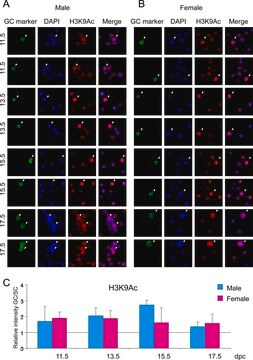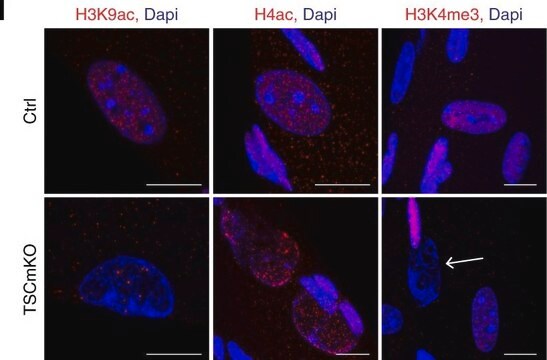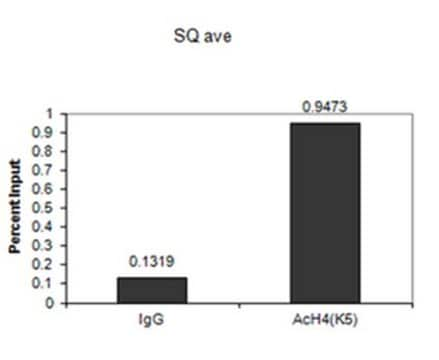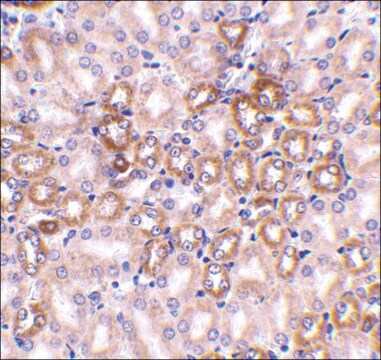17-10493
ChIPAb+ Trimethyl-Histone H3 (Lys36) - ChIP Validated Antibody and Primer Set
from rabbit
Sinônimo(s):
H3K36me2, Histone H3 (dimethyl K36), H3 histone family, member T, Histone 3, H3, Histone cluster 3, H3
About This Item
Produtos recomendados
fonte biológica
rabbit
Nível de qualidade
clone
polyclonal
reatividade de espécies
human, mouse
fabricante/nome comercial
ChIPAb+
Upstate®
técnica(s)
ChIP: suitable (ChIP-seq)
dot blot: suitable
immunoprecipitation (IP): suitable
western blot: suitable
nº de adesão NCBI
nº de adesão UniProt
Condições de expedição
dry ice
Descrição geral
The ChIPAb+ Trimethyl-Histone H3 (Lys36) set includes the Trimethyl-Histone H3 (Lys36) antibody, a negative control antibody (normal rabbit IgG), and qPCR primers which amplify a 147 bp region of human BDNF intron. The Trimethyl-Histone H3 (Lys36) and negative control antibodies are supplied in a scalable "per ChIP" reaction size and can be used to functionally validate the precipitation of Trimethyl-Histone H3 (Lys36)-associated chromatin.
Especificidade
Imunogênio
Histone H3 trimethylated at Lys36 with peptide sequence APATGGV(K)KPHRYRPGC
Aplicação
Sonicated chromatin prepared from HeLa cells (1 X 106 cell equivalents per IP) were subjected to chromatin immunoprecipitation using 2 µg of either Normal rabbit IgG or 2 µL Anti-trimethyl-Histone H3 (Lys36) and the Magna ChIP A Kit (Cat. # 17-610). Successful immunoprecipitation of trimethyl-Histone H3 (Lys36) associated DNA fragments was verified by qPCR using ChIP Primers, BDNF Intron as a positive locus, and GAPDH promoter primers as a negative locus (Please see figures). Data is presented as percent input of each IP sample relative to input chromatin for each amplicon and ChIP sample as indicated.Please refer to the EZ-Magna ChIP A (Cat. # 17-408) or EZ-ChIP (Cat. # 17-371) protocol for experimental details.
Western Blot Analysis and Peptide Inhibition:
Representative lot data.
Recombinant Histone H3 (Catalog # 14-411, lane 1) and chicken Core Histones (Catalog # 13-107, lane 2) were resolved by electrophoresis, transferred to nitrocellulose and probed with antitrimethyl-Histone H3 (Lys36) (1:1000 dilution) or anti-trimethyl-Histone H3 (Lys36) pre-adsorbed with 1mM histone H3 peptides containing the following modifications:
Lane 3: monomethyl-lysine 36
Lane 4: dimethyl-lysine 36
Lane 5: trimethyl-lysine 36
Lane 6: unmodified
Proteins were visualized using a goat anti-rabbit secondary antibody conjugated to HRP and a chemiluminescence detection system. (Please see figures).
Dot Blot Specificity Analysis:
Representative lot data.
Histone peptides with various modifications (see table) were transferred to PVDF membrane and probed with Anti-trimethyl Histone H3 (Lys36) (1:500 dilution). Proteins were visualized using a Donkey Anti-Rabbit IgG secondary antibody conjugated to HRP and a chemiluminescence detection system. (Please see figures).
Epigenetics & Nuclear Function
Histones
Embalagem
Qualidade
Sonicated chromatin prepared from HeLa cells (1e5 cell equivalents per IP) were subjected to chromatin immunoprecipitation using 0.1 µg of either Normal Rabbit IgG (Part No. CS200581), or 0.1 µg Anti-Trimethyl-Histone H3 (Lys36) (Part No.CS207341) and the Magna ChIP® HiSens Kit (Cat. # 17-10460). Successful immunoprecipitation of trimethyl-Histone H3 (Lys36) associated DNA fragments was verified by qPCR using ChIP Primers, GAPDH coding D2 (Part No. CS207323).
Please refer to the Magna ChIP HiSens (Cat. # 17-10460) or EZ-Magna ChIP HiSens (Cat. # 17-10461) protocol for experimental details.
Descrição-alvo
forma física
Normal Rabbit IgG, Part No. CS200581. One vial containing 7.5 µg Rabbit IgG in 75 µL storage buffer containing 0.05% sodium azide. Store at -20°C.
ChIP Primers, GAPDH coding D2. Part No. CS207323. One vial containing 75 μL of 5 μM of each primer specific for human GAPDH coding region (chr12:6647453+6647539 hg19 build) . Store at -20°C.
FOR: 5’ GCC ATG TAG ACC CCT TGA AGA G 3’
REV: 5’ ACT GGT TGA GCA CAG GGT ACT TTA T 3’
Armazenamento e estabilidade
Nota de análise
Includes negative control rabbit IgG antibody and primers specific for human BDNF Intron.
Informações legais
Exoneração de responsabilidade
Código de classe de armazenamento
10 - Combustible liquids
Certificados de análise (COA)
Busque Certificados de análise (COA) digitando o Número do Lote do produto. Os números de lote e remessa podem ser encontrados no rótulo de um produto após a palavra “Lot” ou “Batch”.
Já possui este produto?
Encontre a documentação dos produtos que você adquiriu recentemente na biblioteca de documentos.
Nossa equipe de cientistas tem experiência em todas as áreas de pesquisa, incluindo Life Sciences, ciência de materiais, síntese química, cromatografia, química analítica e muitas outras.
Entre em contato com a assistência técnica








